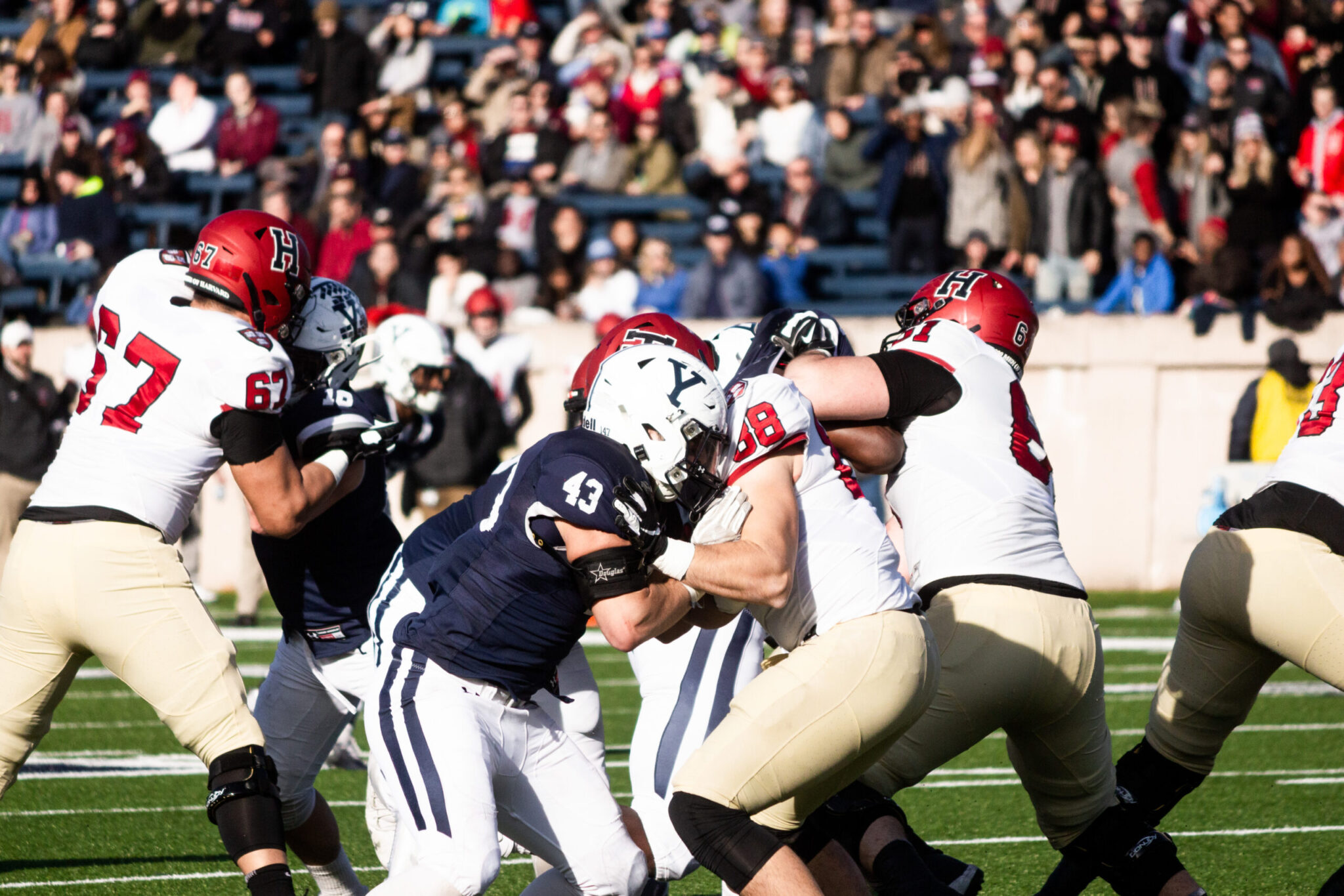How does the Yale-Harvard rivalry stack up against other great college football rivalries?
The Game may be the greatest rivalry in the Ivy League, but is it the best rivalry in all of college sports?

Daniel Zhao, Senior Photographer
The Game may seem like the biggest sporting event of the year for many Yale and Harvard students, but for most Yale students, it is the only sports game they will attend all year. Some may be surprised to learn that there are, in fact, other college rivalries that are just as big, if not bigger, than Yale-Harvard.
One such rivalry — possibly the most fearsome in collegiate athletics — is Michigan vs. Ohio State. Ironically, when these two teams match up against each other, it is also called “The Game.” And for this one, millions of eyes around the country are glued to their TV sets for Fox’s national Big Noon Kickoff coverage.
“Michigan vs. Ohio State goes beyond football,” Penn State undergrad Jacob Zucker told the News. “I met somebody in Ohio that wasn’t an Ohio State fan, but he said he would never step foot in the state of Michigan. He grew up hating the state of Michigan.”
What differentiates rivalries like Michigan-Ohio State from Yale-Harvard is that the rivalry extends beyond student enthusiasm. The resentment is omnipresent, according to Zucker. It is about statehood, not alumni status, he explained. Affiliation with either school has little impact on fans’ investment in the competition.
When it comes to garnering outside support, Yale-Harvard struggles to keep up. Generally, no New Haveners, much less all residents of Connecticut, care so much about the Yale-Harvard rivalry that they would refuse to step foot in Massachusetts, or even Boston.
Down in Alabama, The Iron Bowl — the annual Auburn-Alabama matchup — is so culturally significant that one cannot even live in the state without being constantly pestered about which team they support, according to Cailin White, an Auburn undergraduate who moved to Alabama when she was 13 years old.
“When I moved to Alabama, I quickly discovered that to live here you’re either an Auburn fan or a Bama fan,” said White.
The college rivalry is a deep-rooted part of Alabama’s culture, having been an annual tradition since 1893.
Families clash over it at the dinner table. Children are raised to pick sides. It is just a part of living in the state – a part of the lifestyle, White said.
“We had Auburn and Alabama-themed dress-up days and fundraisers in elementary school. The rivalry starts so young,” Evan White, who is from Alabama and is a student at Tuskegee University, told the News.
The rivalry is so intense that after an Iron Bowl loss in 2010, Alabama fan Harvey Updyke Jr. poisoned the iconic Toomer’s Oaks, the beloved decades-old trees that Auburn fans roll in toilet paper after every win. Updyke was sentenced to six months in jail for the killing of the beloved Auburn trees.
The loss of the historic trees devastated the Auburn community around the country.
“I wanted Auburn people to hate me as much as I hate them,” Updyke told CBS News. “There are several things in this world that I really and truly don’t like, and Auburn is one of them.”
Now, when it comes to student enthusiasm for the rivalry, Yale-Harvard holds its own with the other big games.
When it comes time for kickoff in such big rivalry games, students are much more than just fans. They are a highly trained squadron, and they are more than capable of wreaking havoc on the opposing team. By the time rivalry week rolls around, they are operating as a well-oiled machine.
“The Penn State fans and the students feel like they have a job to do just like the players,” said Zucker. “Defend home field at all costs. The student section has the same mentality as the team – it’s all about winning and execution.”
Yale students show just as much school spirit and enthusiasm the week of The Game as students at any other one of the aforementioned schools.
The entire week leading up to The Game, Yale’s campus is packed with rivalry-themed events. Come gameday, students tailgate and support their team as zealously as any Big 10 or SEC student section. The gameday energy is right up there with the best of them.
Possibly the greatest prank against another team in college sports was pulled off by Yale students in 2004.
Elis dressed as a “Harvard Pep Squad” and passed out 1,800 pieces of red and white construction paper to Crimson fans, telling the crowd that when they held up the pieces of paper, they would spell out “Go Harvard.” The Yalies’ plan fell right into place as Harvard fans unknowingly spelled out “We Suck” across a section of their stadium.
Even if the Ivy rivalry may not draw as fanatic fans as some of the other games do, the institutional competition between Yale and Harvard stands alone. Both schools personify tradition like no other. After all, their historic legacies do predate the founding of the United States.
“The birth of America was in the Northeast. Yale and Harvard, they’re synonymous with the birth of our nation,” a University of Southern California graduate who is from Los Angeles Justin Petrille said. “They’re the two most historic schools of our country, and they’ve always been rivals to one another. Yale-Harvard, everyone knows that — even if you’re not a sports fan.”
The first Yale-Harvard football game was played in 1875.







